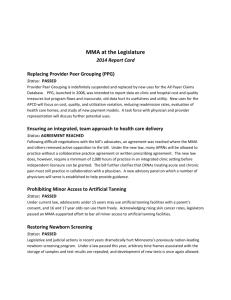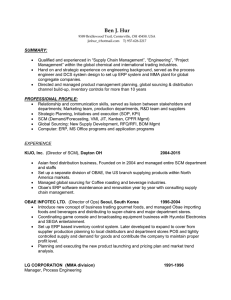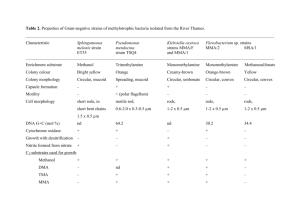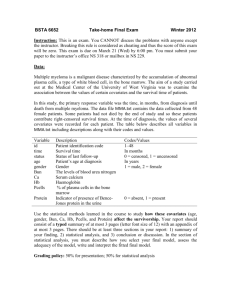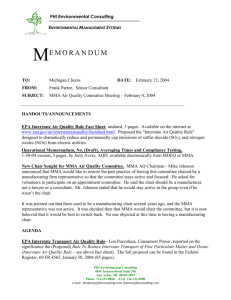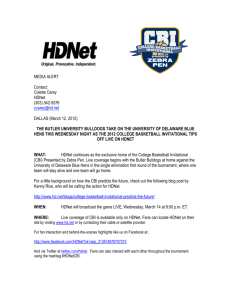Document 10655182
advertisement
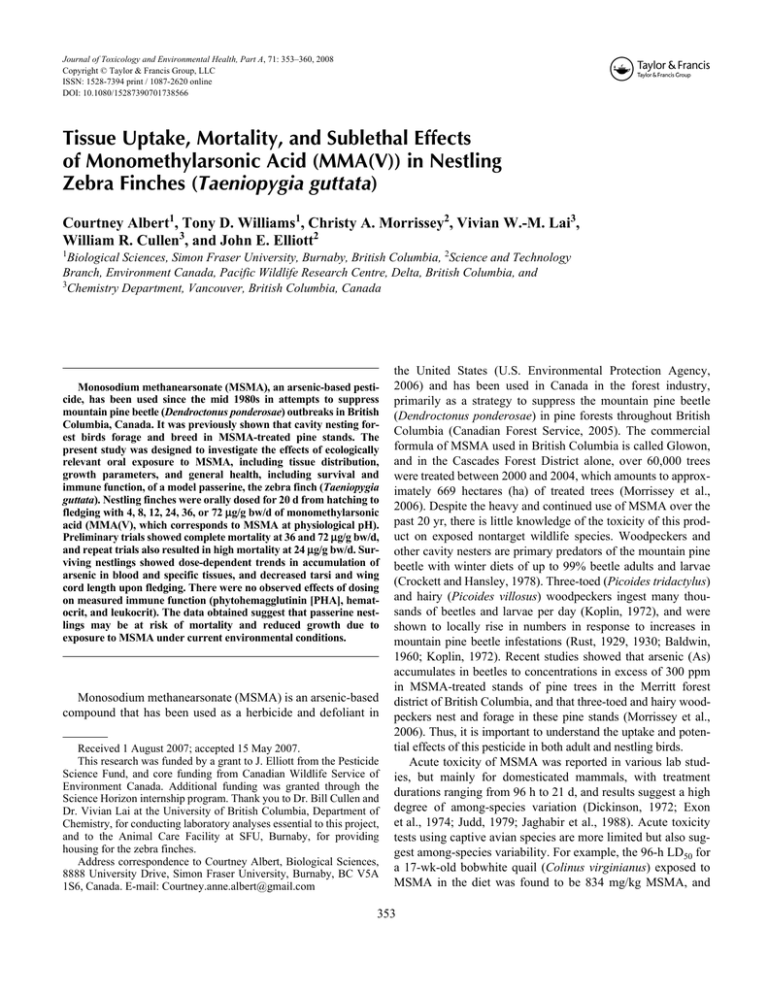
Journal of Toxicology and Environmental Health, Part A, 71: 353–360, 2008 Copyright © Taylor & Francis Group, LLC ISSN: 1528-7394 print / 1087-2620 online DOI: 10.1080/15287390701738566 Tissue Uptake, Mortality, and Sublethal Effects of Monomethylarsonic Acid (MMA(V)) in Nestling Zebra Finches (Taeniopygia guttata) UTEH Courtney Albert1, Tony D. Williams1, Christy A. Morrissey2, Vivian W.-M. Lai3, William R. Cullen3, and John E. Elliott2 MMA(V) Toxicity To Nestling Zebra Finches 1 Biological Sciences, Simon Fraser University, Burnaby, British Columbia, 2Science and Technology Branch, Environment Canada, Pacific Wildlife Research Centre, Delta, British Columbia, and 3 Chemistry Department, Vancouver, British Columbia, Canada Monosodium methanearsonate (MSMA), an arsenic-based pesticide, has been used since the mid 1980s in attempts to suppress mountain pine beetle (Dendroctonus ponderosae) outbreaks in British Columbia, Canada. It was previously shown that cavity nesting forest birds forage and breed in MSMA-treated pine stands. The present study was designed to investigate the effects of ecologically relevant oral exposure to MSMA, including tissue distribution, growth parameters, and general health, including survival and immune function, of a model passerine, the zebra finch (Taeniopygia guttata). Nestling finches were orally dosed for 20 d from hatching to fledging with 4, 8, 12, 24, 36, or 72 mg/g bw/d of monomethylarsonic acid (MMA(V), which corresponds to MSMA at physiological pH). Preliminary trials showed complete mortality at 36 and 72 mg/g bw/d, and repeat trials also resulted in high mortality at 24 mg/g bw/d. Surviving nestlings showed dose-dependent trends in accumulation of arsenic in blood and specific tissues, and decreased tarsi and wing cord length upon fledging. There were no observed effects of dosing on measured immune function (phytohemagglutinin [PHA], hematocrit, and leukocrit). The data obtained suggest that passerine nestlings may be at risk of mortality and reduced growth due to exposure to MSMA under current environmental conditions. Monosodium methanearsonate (MSMA) is an arsenic-based compound that has been used as a herbicide and defoliant in Received 1 August 2007; accepted 15 May 2007. This research was funded by a grant to J. Elliott from the Pesticide Science Fund, and core funding from Canadian Wildlife Service of Environment Canada. Additional funding was granted through the Science Horizon internship program. Thank you to Dr. Bill Cullen and Dr. Vivian Lai at the University of British Columbia, Department of Chemistry, for conducting laboratory analyses essential to this project, and to the Animal Care Facility at SFU, Burnaby, for providing housing for the zebra finches. Address correspondence to Courtney Albert, Biological Sciences, 8888 University Drive, Simon Fraser University, Burnaby, BC V5A 1S6, Canada. E-mail: Courtney.anne.albert@gmail.com the United States (U.S. Environmental Protection Agency, 2006) and has been used in Canada in the forest industry, primarily as a strategy to suppress the mountain pine beetle (Dendroctonus ponderosae) in pine forests throughout British Columbia (Canadian Forest Service, 2005). The commercial formula of MSMA used in British Columbia is called Glowon, and in the Cascades Forest District alone, over 60,000 trees were treated between 2000 and 2004, which amounts to approximately 669 hectares (ha) of treated trees (Morrissey et al., 2006). Despite the heavy and continued use of MSMA over the past 20 yr, there is little knowledge of the toxicity of this product on exposed nontarget wildlife species. Woodpeckers and other cavity nesters are primary predators of the mountain pine beetle with winter diets of up to 99% beetle adults and larvae (Crockett and Hansley, 1978). Three-toed (Picoides tridactylus) and hairy (Picoides villosus) woodpeckers ingest many thousands of beetles and larvae per day (Koplin, 1972), and were shown to locally rise in numbers in response to increases in mountain pine beetle infestations (Rust, 1929, 1930; Baldwin, 1960; Koplin, 1972). Recent studies showed that arsenic (As) accumulates in beetles to concentrations in excess of 300 ppm in MSMA-treated stands of pine trees in the Merritt forest district of British Columbia, and that three-toed and hairy woodpeckers nest and forage in these pine stands (Morrissey et al., 2006). Thus, it is important to understand the uptake and potential effects of this pesticide in both adult and nestling birds. Acute toxicity of MSMA was reported in various lab studies, but mainly for domesticated mammals, with treatment durations ranging from 96 h to 21 d, and results suggest a high degree of among-species variation (Dickinson, 1972; Exon et al., 1974; Judd, 1979; Jaghabir et al., 1988). Acute toxicity tests using captive avian species are more limited but also suggest among-species variability. For example, the 96-h LD50 for a 17-wk-old bobwhite quail (Colinus virginianus) exposed to MSMA in the diet was found to be 834 mg/kg MSMA, and 353 354 C. ALBERT ET AL. 10-d-old bobwhite yielded a 96-h LD50 of approximately 650 mg/kg/d (MMA Task Force Three, 1993). However, mallards tested on the same dosing scheme showed no effects or mortality even at the highest dose administered (1100 mg/kg/d; MMA Task Force Three, 1993). In addition to acute toxicity, various sublethal effects of MSMA were reported in several lab mammals, including decreased hematocrit and blood glucose levels (Judd, 1979), gastrointestinal irritation, frequent vomiting and diarrhea (MMA Task Force Three, 1993), and behavioral abnormalities and lowered reproductive capabilities (Prukop & Savage, 1986). Methylated arsenicals also produce adverse developmental effects including malformations, and abnormal and slowed development of offspring in mice (Rogers et al., 1981), embryonic resorption and decreased mean fetal weight in hamsters (Hood et al., 1982; Hood, 1998), and decreased growth in rats (Rodriguez, 2002). There have been few similar studies in birds, though Hoffman et al., (1991) reported some reduction in growth in mallard ducklings dosed with environmentally relevant concentrations of sodium arsenate. Studies on the fertility and hatching success in breeding birds, as well as sublethal effects in nestlings, exposed to MSMA are lacking in the literature. In this study the tissue distribution, growth parameters and general health of nestling zebra finches (Taeniopygia guttata) orally dosed with monomethylarsonic acid (MMA(V)) was investigated as a model for cavity-nesting birds that might be affected as nontarget species by MSMA-treatment against bark beetle (e.g., woodpeckers, chickadee). Specifically, nestlings were dosed daily with MMA through the entire nestling period and were measured in terms of chick growth, mortality or fledging success, leukocrit, hematocrit, and a measure of cellmediated immunity (using the phytohemagglutinin [PHA] test). MMA(V) was used as it corresponds to MSMA at gastrointestinal pH (Dost, 1995) and is the primary form of As detected in the bark beetle samples collected in MSMA-treated pine stands in British Columbia (Morrissey et al., 2007). Furthermore, ecologically relevant doses were used, which were calculated based on total As detected in bark beetle samples (Morrissey et al., 2007) and food-ingestion rates of free-living woodpeckers (Nagy, 2001), which were extrapolated to the zebra finch. METHODS Animals, Husbandry, and General Experimental Protocol This experiment was conducted using captive zebra finches in the Simon Fraser University Animal Care Facility located in Burnaby, British Columbia, Canada. Finches were maintained in Canadian Committee on Animal Care (CCAC)-accredited facilities, with a constant 14 h light:10 h dark cycle at 19–23°C and 35–55% humidity. All birds were provided with a mixed seed diet (panicum and white millet, 50:50; approximately 12% protein, 4.7% lipid; Just For Birds, Surrey, BC), water, grit, and cuttlefish bone ad libitum. Experiments and animal husbandry were conducted under a Simon Fraser University Animal Care Committee permit (666B-03). All work was conducted following CCAC guidelines. For all experiments the same basic protocol was followed for breeding and chick rearing. Experienced, adult zebra finches were randomly paired in individual breeding cages (61×46×41 cm), each with an external nest box (15×14.5×20 cm). In addition to the ad libitum seed diet, breeding birds were provided with a high-quality egg food supplement daily (approximately 6 g) until clutch completion (2 d after the last egg was laid) and then again during the chick-rearing stage. Nest boxes were monitored daily for egg laying, and eggs were numbered in consecutive order and weighed (±0.001 g) to confirm normality of the reproductive cycle and nest productivity. Breeding pairs that did not produce eggs within 2 wk following pairing were separated and classified as “nonbreeders.” Nest boxes were then checked again daily toward the end of the 12- to 14-d incubation period to determine hatching dates. Within 24 h of hatching, individual chicks within each nest were marked with food coloring for identification and randomly assigned to a control, low, medium, or high MMA solution dose group (see later details of dosing). Each nest therefore contained a control chick and one to four chicks randomly assigned to one of the MSMA treatment groups (low, medium, high), depending on brood size. Normal brood size for zebra finches is four to six (Zann, 1996). Some large broods of five or six had more than one control chick, and we then used the average value of the two chicks for subsequent analysis. Nestlings were orally dosed with MMA daily from hatching (d 1) to fledging (d 21) of the nestling period, using a micropipette or via intubation. Control nestling were dosed with the vehicle, deionized distilled water, using the same method. There were no adverse effects observed with this dosing approach. MMA doses were adjusted daily based on daily measures of individual chick weight. As chicks increased in mass with age, dosage volumes ranged from 10 to 130 μl depending on chick age. From d 1 to d 21 all nestlings were weighed and measured daily, and all surviving nestlings were banded at 10 d of age. Nestlings were returned to the nests immediately after handling and dosing. There were no observed adverse effects with the dosing approach. Determination of Dosing Levels, Tissue Uptake, Hematology, and Sublethal Effects of MMA(V) on Nestling Zebra Finches Given the lack of information in the literature on dosing levels for MMA and evidence of species specificity, pilot studies were conducted to determine (1) dosing levels for our main study on the sub-lethal effects of MMA(V) and (2) patterns of uptake and tissue distribution in nestlings dosed with MAA(V). Technical-grade MMA(V) (University of British Columbia Chemistry Department) was dissolved in deionized MMA(V) TOXICITY TO NESTLING ZEBRA FINCHES distilled water to obtain solutions of appropriate concentrations. All solutions were analyzed prior to administration, and were within 10% of the target dose. Although the commercial formula of this pesticide contains additional ingredients that may affect the toxicity of the compound, the technical grade of MMA(V) was used to determine the toxicity of the active ingredient. However, future research testing the toxicity of the commercial formula for comparison is warranted. This experimental work was part of a larger study of the effects of MSMA treatment against mountain pine beetle on nontarget avian species in British Columbia forests (Morrissey et al., 2007). As a consequence, our dose calculations were based on As concentrations found in bark beetles collected in the MSMA-treated stands in British Columbia, incorporating additional information such as food requirements for three species of woodpeckers (three-toed, hairy, and black-backed woodpeckers) (Nagy, 2001), and the average food ingestion rate (daily dry matter intake) was based on the average body mass of these woodpeckers (Dunning, 1993). The doses were extrapolated to the lab colony of zebra finches based on their individual mass, and volumes administered were calculated daily based on their daily mass. Mountain pine beetle samples contained up to 700 μg/g dry weight total As, with the monomethylarsonic acid (MMA(V)) species contributing to over 90% of the total (Morrissey et al., 2006). Therefore, the initial dosing scheme used in this experiment was based on 0, 50, 150, or 450 μg/g in beetle prey to encompass the range of MMA(V) concentrations found in the bark beetle samples giving doses of 0, 8, 24, or 72 μg/g MMA(V) per day (Albert, 2006). In the first pilot study, zebra finch nestlings were exposed to these ecologically relevant doses of 0, 8, 24, or 72 μg/g MMA(V) (Table 1). This resulted in complete mortality at 24 and 72 μg/g bw/d (see Results). A second pilot experiment was then conducted using lower doses of 0, 4, 12, or 36 μg/g MMA(V). Due to the small sample size of the first pilot study, a high dose of 36 μg/g was included to ensure this was a lethal dose. Although unexpected, this again resulted in complete TABLE 1 Number of Nestlings Orally Dosed with MMA(V) and Total Percentage Mortality MMA(V) dose (μg/g body weight) Experiment 0 4 8 12 24 36 72 Pilot 1 0/5 0/4 5/5 7/7 Pilot 2 0/4 1/5 5/5 5/5 Main first trial 1/25 2/21 3/23 Main second trial 0/14 0/11 1/12 13/21 Number dead 1 3 0 9 18 5 7 Total number 48 26 15 40 26 5 7 nestlings Percent mortality 2 11 0 23 69 100 100 355 mortality for both the 12- and 36-μg/g bw/d dosed nestlings (see Results). As the primary goal of our study was to investigate sublethal effects of MSMA, it was decided to use even lower doses of 0, 4, 8, 12, or 24 μg/g MMA(V) in our primary experiments. Again, since the second pilot study sample size was so low, a high dose of 24 μg/g was included in our primary study to ensure this was a lethal dose. In the second pilot study all surviving nestlings in the 0- and 4-μg/g MMA(V) dose groups were anesthetized on d 21 via an intramuscular injection of 50 μl ketamine:xylazine solution (50:50 by volume; Associated Veterinary Products, Abbotsford, British Columbia) followed by exsanguination. Blood samples were collected via both the jugular and brachial veins using heparinized pipettes or capillary tubes and transferred to heparinized centrifuge tubes. Within 1 h of being collected, whole blood samples were frozen at −20ºC. Liver, kidney, and brain tissues were obtained through dissection, weighed, and frozen prior to being freeze-dried and sent to the University of British Columbia for total As analysis. Additional blood samples were taken using a heparinized capillary tube to determine hematocrit and leukocrit, two additional toxicity endpoints in the pilot study. Hematocrit is a measure of the total packed red blood cells in a blood sample and may indicate the amount and efficiency of oxygen uptake and transfer to tissues (Ots et al., 1998). Leukocrit is a measure of total white blood cells in a blood sample, and indicates humoral immune function (Wardlaw & Levine, 1983). Both hematocrit and leukocrit were measured by centrifuging the capillary tubes of blood for 3 min at 5000 rpm, and the heights of the leukocrit, hematocrit, and total sample were then measured using a digital caliper (0.01 mm). To remain consistent, all measurements of hematocrit and leukocrit were made by the same researcher. Our main experiment was conducted in two repeated trials during August–September 2005 and November–December 2006, each carried out in exactly the same way and under the same standardized conditions as described already. Data from both experiments were pooled for analysis. In each trail, n = 40 adult pairs were used, and between the two trials a total of 30 pairs successfully reared chicks to fledging; only pairs with broods of more than 2 nestlings were used in dosing experiments. Although measurements were recorded daily, nestling growth was measured by body mass on d 1, 5, 10, 15, and 21 posthatching, and right tarsus and wing cord length were measured at fledging. Immune function was measured by conducting a phytohemagglutinin (PHA) cell-mediated immune function test (Smits & Williams, 1999) on all nestlings at 21 d of age. The process involved a wing web injection of 30 μl lectin (kidney bean extract) in the left wing web of each nestling. The right wing web received an injection of 30 ul phosphatebuffered saline (PBS), which served as a control. Prior to injection, the feathers in the injection area were plucked and injections were given using an insulin syringe. Thicknesses of wing webs were measured 24 h later using calipers to quantify inflammation as a measure of immune response. Blood samples were 356 C. ALBERT ET AL. collected from 5 randomly chosen nestlings per dose group at d 21 to determine total blood As content, taken via both the jugular and brachial veins using heparinized pipettes and capillary tubes and transferred to heparinized centrifuge tubes. Blood samples were frozen at −20°C within 1 h. Hematocrit and leukocrit were also measured as described earlier. MMA Analysis Dosing solutions, blood, and organ tissues were sent to Dr. William Cullen’s Chemistry Laboratory at the University of British Columbia, Vancouver, BC, where they were measured for As content. Within the literature, monomethylarsonic acid is abbreviated as MMA, MAA, and MMAA. To avoid confusion, only MMA is used throughout this article. Based on the metabolic pathway of ingested MMA(V), there are two valences one might expect to detect; MMA(V) in its original form or MMA(III), a more acutely toxic, unstable form of methylated As. However, our chemical analysis did not distinguish between different valences. Therefore, MMA and DMA were reported to represent both valences (III) and (V). Samples were analyzed for total As as described previously by Lai et al. (2004). Briefly, blood and tissue samples were weighed into glass test tubes and 2 ml nitric acid and 3 Teflon boiling chips were added to each tube. The samples were heated in a test tube block heater at temperatures increasing stepwise from 70 to 150ºC and then cooled overnight. Hydrogen peroxide (2 ml) was added to the samples on the next day and the samples were heated to 150ºC until they were evaporated to dryness. The residue was redissolved in 4 ml of an aqueous solution containing 1% (v/v) nitric acid and 5 ppb rhodium. The samples were mixed thoroughly by using a vortex mixer and filtered (0.45 um). The samples were stored at 4ºC until analysis. Digested blood and tissue samples were diluted appropriately with the rhodium–nitric acid solution and analyzed for total As using Inductively coupled plasma-mass spectrometry (ICP-MS). All reagents used were of high purity suitable for ICP-MS analysis. Quality assurance included the analysis of standard reference materials: dogfish muscle (DORM-2) from National Research Council Canada and Fucus sample (IAEA-140) from International Atomic Energy Agency. Kelp powder was purchased from a local food store in Vancouver, BC, and is used as an internal laboratory standard (Lai et al., 1997). Statistical Analyses All statistical analyses were conducted using JMP (Version 5.0, SAS Institute, Inc., 2003). A Shapiro–Wilks W-test (Version 5.0, JMP, SAS Institute, Inc., 2003) showed that the blood As data deviated significantly from normality, and therefore data were log10 transformed prior to analysis to meet assumptions of normality for subsequent parameteric statistical analyses. Analysis of variance (ANOVA) was used to determine differences in As residues in blood and tissues between all treatment groups, including control birds. Where differences existed, Tukey’s honestly significant difference (HSD) tests were used to identify which treatment levels differed significantly in their response to MMA(V) exposure. To determine whether there was a difference in weight gain among dose groups during the dosing period, a repeated-measures ANOVA was conducted for each of the pilot and main studies. Paired t-tests were used to determine significant differences in body mass, cell-mediated immunity, and tarsus length at d 21 between treatment and control groups among nests. This within-nest analysis thus controlled for confounding factors such as brood size and parental quality. The criterion for significance was set at p < .05. RESULTS Mortality, Tissue Uptake, and Sublethal Effects on Growth and General Health Mortality was higher than expected in both pilot studies. All nestlings in the 72-μg/g (n = 7), 36-μg/g (n = 5), 24-μg/g (n = 5), and 12-μg/g (n = 5) dose groups died in the pilot studies. Similarly, in the main study with larger sample sizes, 62% of nestlings dosed with 24 μg/g died (13/21) and 11% of nestlings dosed with 12 μg/g (4/35) died in the main study. In contrast, overall mortality was relatively low in the 8-, 4-, and 0- (control) μg/g dose groups (see Table 1 for complete mortality data). Combined total concentrations of As detected in whole blood samples from surviving nestling zebra finches from both the second pilot study and the main study are shown in Figure 1. In the pilot study, nestlings dosed with 4 μg/g MMA(V) had FIG. 1. Total blood arsenic detected in nestling zebra finches dosed with 4, 8, or 12 μg/g MMA(V) relative to controls. Pilot and main study data combined. Total As expressed in μg/g dry weight. Results are shown as the mean ± standard deviation with the sample size within each plot in parentheses. Different letters indicate significant difference at p < .05. 357 MMA(V) TOXICITY TO NESTLING ZEBRA FINCHES significantly higher levels of As in the blood compared to the control. In the main study, nestlings dosed with 8 and 12 μg/g had significantly higher mean total blood As levels. Control birds had trace amounts of As in the blood, which may be attributed to background levels resulting from “natural” exposure of metal in drinking water and food. All organ tissues analyzed from surviving nestlings in the second pilot study contained total As residues that were higher in nestlings dosed with 4 μg/g bw/d MMA(V) compared to control nestlings (Figure 2). In the 4-μg/g dosed birds, the liver contained the highest amount of arsenic, ranging from 1.13 to 3.6 μg/g, followed by kidney with a range of 1.04 to 2.59 μg/g (mean: 2.01 ± 0.22 μg/g). The brain tissue had the lowest total As, ranging from 0.52 to 1.34 μg/g (mean: 1.08 ± 0.11 μg/g). There was a marginally significant difference in concentrations of As among tissues. For the first pilot study the number of surviving chicks was too small to perform statistical analysis, but for the second pilot study surviving nestlings dosed with 4 μg/g bw/d MMA(V) showed no overt signs of ill health. Nestlings were FIG. 2. Total arsenic in liver, kidney, and brain tissue of nestlings dosed with control and low (4 μg/g MMA(V)) in pilot study number 2. Data are expressed as the mean ± standard error. Sample sizes are in parentheses. weighed daily, and weight gain did not differ significantly between treatment groups. Body mass at d 21 did not differ between control and 4-μg/g groups. Similarly, hematocrit and leukocrit at fledging were not significantly different among dose groups. As in the previous pilot studies, in the main experiment, the pattern of growth, or change in body mass over the 21-d nestling period did not differ among MMA(V) dose groups. Similarly, body mass on d 21 did not differ between control and treatment groups (Table 2). Although tarsus length at d 21 did not differ between controls and the 4-μg/g dose group, tarsus length was significantly shorter in the 8-, 12-, and 24-μg/g dose groups compared with controls (Table 2). Similarly, wing cord length (measured in the second trial only) did not differ between the control and 8-μg/g dose groups, but birds in the 12- and 24-μg/g dose groups had significantly shorter wing cord length than control nestlings (Table 2). There were no effects of brood size on body mass, tarsus length or wing cord at d 21 (brood sizes ranged from 2 to 6 in this study). Cell = mediated immune response to PHA was apparently not affected by MMA(V) treatment. DISCUSSION In this study it was of interest to determine sublethal effects of oral exposure to MMA(V) on general health and growth in nestling zebra finches as a model for effects of MMA(V) on nontarget forest birds (Morrissey et al., 2007) Although they were not intended to investigate lethal effects of MSMA, our range-finding pilot studies showed that dosing nestling zebra finches with MMA(V) at levels detected in bark beetles from MSMA-treated trees results in high mortality. Among surviving nestlings, dose-dependent relationships were found in blood and tissue MMA(V) concentrations. Despite the magnitude of MMA uptake, few effects were noted from MMA(V) exposure on general health parameters (cell-mediated immunity, hematocrit, leukocrit) or in growth as measured by body mass. However, evidence of reduced growth was found based TABLE 2 Comparison of Body Mass, Wing Cord Length, Tarsus Length, PHA, Hematocrit, and Leukocrit Values of Nestling Zebra Finches Dosed with 0, 4, 8, 12, or 24 μg MMA(V)/g Body Weight Over 21 Days Dosage group Mean body mass, Wing cord length, (μg/g) d 21 (g) d 21 (mm) 0 (control) 4 8 12 24 11.89 ± 0.12 (35) 18.1 ± 0.2 (10) 11.85 ± 0.15 (20) N/A 11.76 ± 0.14 (26) 17.82 ± 0.13 (10) 11.76 ± 0.12 (29) 17.48 ± 0.18 (11) 11.41 ± 0.28 (6) 17.23 ± 0.22 (7) Tarsus length, d 21 (mm) PHA (mm) Hematocrit (%) Leukocrit (%) 17.27 ± 0.103 (31) 0.467 ± 0.04 (17) 55.78 ± 1.13 (4) 7.75 ± 1.60 (4) 16.6 ± 0.11 (13) 0.496 ± 0.05 (15) 53.38 ± 1.01 (5) 6.60 ± 1.43 (5) 16.99 ± 0.12 (25) 0.482 ± 0.04 (14) N/A N/A 16.79 ± 0.11 (24) 0.53 ± 0.05 (17) N/A N/A 16.81 ± 0.16 (8) N/A N/A N/A Note. Values are expressed as mean ± standard error. Samples sizes are in parentheses. Significant values are in boldface type (p < .05). Pilot and both main trials are included. 358 C. ALBERT ET AL. on measures of skeletal or body size: tarsus and wing cord length at fledging at MMA(V) concentrations as low as 8 μg/g, which is equivalent to consuming a diet of beetles with a concentration of 50 μg/g As. In a previous study using adult zebra finches and orally administering doses of MMA(V) at 0, 8, 24, or 72 μg/g, Albert (2006) reported no mortality even at the highest dose levels. Although there was a high level of excretion (>90%) of As in all dose groups, there was a dose-dependent accumulation of As in the blood and other tissues (kidneys, liver, brain). MMA(V) treatment was also associated with reduced body mass in the 24- and 72-μg/g dose groups (Albert, 2006). The high mortality of nestlings in the current study as compared with adults on the same dosing scheme suggests that nestlings are much more sensitive to MMA(V). Young developing birds frequently exhibit increased sensitivity to metal exposure compared with adults (Scheuhammer, 1987). Nestlings likely lack the ability of adults to rapidly methylate and excrete the compound. This might be due to underdeveloped metabolic processes in the nestlings, as these are altricial birds and their tissues are still undergoing functional differentiation (Hoffman 2003); thus, their organs may be unable to cope with exposure to a potentially toxic compound while developing. Administration of high concentrations of MMA(V) may cause the nestlings to rapidly absorb the compound, and biotransformation capabilities of the nestling tissues may become quickly saturated. Nestlings are likely to become exposed to MMA(III) during biotransformation, which may be binding to critical thiol groups, inhibiting crucial biochemical reactions and leading to cytotoxicity (Hughes, 2002). This would ultimately lead to failure of specific organs and tissues and result in death of the nestlings. Conversely, nestlings dosed with much lower concentrations of 4 and 8 μg/g MMA(V) experienced a much higher survival rate, with no apparent sublethal toxicity. In this case, nestlings may be experiencing a threshold effect, whereby metabolism and excretory mechanisms are able to cope with the compound at lower doses, and subsequently experience less toxicity. Exposure to MMA(V) was verified with analysis of blood and tissue As residues. From the combined data it was noted that there is accumulation of As in blood, and in all experiments, all dose groups had more total blood As than the control. Tissue distribution results showed up to 3.6 μg/g As in liver, 2.59 μg/g in kidneys, and 1.34 μg/g in brain of 4 μg/g dosed nestlings. Histopathological effects of this tissue uptake and accumulation were not assessed. However, based on the finding of Jaghabir et al. (1989), who observed lesions in several tissues of New Zealand White rabbits (Oryctalagus cuniculus) dosed with MSMA, clearly further investigation of potential pathological effects is warranted. In addition, studies on the possible effects produced by accumulation of As in the liver and kidneys would be useful in determining the overall risk of exposure to MMA(V). When compared to adult zebra finches dosed with the same concentrations of MMA(V) (Albert, 2006), it is clear that nestling zebra finches are more susceptible to accumulation in organ tissues than adults, but not in the blood. Nestlings dosed with 8 μg/g MMA(V) had an average of 0.19 μg/g As in blood, while adults dosed with 8 μg/g MMA(V) had an average of 0.45 μg/g arsenic in blood. Adults dosed with twice as much MMA(V) (8 μg/g) had up to only 0.19 μg/g As in liver, 0.3 μg/g in kidneys, and 0.2 μg/g in brain. Our results are similar to those from studies of uptake of other metals using wild bird populations, examining age differences in accumulation of As, selenium, and manganese, which reported a decrease in tissue and blood concentrations with age (Burger & Gochfeld, 1999). Since our study was conducted in a controlled lab setting, one can rule out any possible factors that may be contributing to age differences, such as differences in colony/habitat, or seasonal effects. It was shown that adult mammals absorb an average of 2% of ingested inorganic mercury, while young mammals absorb an average of 35% (Kostial et al., 1978). In both adult (Albert, 2006) and nestling zebra finches, MMA(V) exposure resulted in appreciable amounts of As accumulating in brain tissue. As has the ability to cross the blood–brain barrier, and was shown to accumulate in brain and produce neurotoxic effects in rats by altering ATP metabolism, neurons, and glia (Nagaraju & Desiraju, 1993; Valkonen et al, 1983). Nagaraju and Desiraju (1993) showed that developing rats exposed to low doses of 5 μg/g inorganic As for 60 d had delayed eye opening, reduced weight gain, and irreversible body and brain weight deficits. The authors suggested that chronic exposure to As may have induced irreversible reorganization of the developing brain. In addition, arsenate was shown to alter brain ATP metabolism (Camardese et al., 1990) and to produce behavioral changes (Whitworth et al., 1991) in mallard ducklings. Given the observed accumulation in zebra finch brain tissue, future studies examining possible neurological and behavioral effects of MMA(V) as well as developmental effects on these systems in passerines are warranted. Despite evidence of As uptake into blood, and accumulation of As in key tissues such as liver, kidneys, and brain, few sublethal effects were found on general health of nestlings, at least in the short term up to fledging. Body mass, cell-mediated immune response, and hematological parameters of nestlings at d 21 were not affected by MMA(V) dosing. Despite the lack of general health effects in our study, a significant effect of MMA(V) was shown on growth using measures of skeletal or body size. Tarsus length of nestling zebra finches in the 8, 12, and 24 μg/g MMA(V) dose groups were significantly shorter than those of controls, and wing cord length was significantly shorter in 12- and 24-μg/g dose groups than in controls. This is consistent with a previous study of free-living nestling pied fly-catchers (Ficedula hypoleuca) exposed to a variety of heavy metals, which exhibited growth abnormalities of the wings and legs with increased metal exposure, with no effect on growth rate (Eeva & Lehikoinen, 1996). However, flycatchers with leg and wing growth abnormalities were unable to fledge, while nestlings in the current study all fledged successfully. Shorter tarsi and wing MMA(V) TOXICITY TO NESTLING ZEBRA FINCHES cord length in the zebra finches may be due to a possible interaction between As and the mineral fraction of the bone. Kretschmer et al. (2002) suggested that As in bone may be associated with the mineralized calcium phosphate, or hydroxyapatite, with As likely replacing the phosphate. Hydroxyapatite is an important part of the framework in bones, making them strong and rigid (Heaney, 1999). A possible interaction between As and phosphate in the hydroxyapatite may have consequences in developing birds by interfering with normal bone deposition. However, it is likely As in the form of inorganic arsenate (As(V)) would be substituting the phosphate in this interaction, and demethylation of MMA(V) to inorganic As is highly unlikely (Yamauchi et al., 1988). Shorter tarsi and wing cord length in the nestlings appeared to exert no effect on the general health and fledging success of the nestling zebra finches. However, zebra finch nestlings were held in a controlled lab setting, and determining the effects of shorter tarsi and wing cord length in wild passerine fledglings on future fitness (e.g. anti-predatory responses) requires further study. In addition, it remains unknown whether As accumulation in nestlings has longer term effects in terms of post-fledging survival or reproduction. Blood samples from woodpeckers and other forest birds occupying MSMA stands and potentially exposed to contaminated bark beetles in southern British Columbia ranged from 0.03 to 3.73 μg As/g dry weight (dw) (Morrissey et al., 2006). Nestling mountain chickadees (Poecile gambeli) in the same region had total blood As values ranging from 0.07 to 1.88 μg arsenic/g dw blood just prior to fledging (Morrissey et al., 2007). Zebra finch nestlings experimentally exposed to similar concentrations of MMA(V) (24, 36, or 72 μg/g) did not survive. Nestlings dosed with lowered concentrations of MMA(V) (4, 8, or 12 μg/g) had total blood As values ranging from 0 to 0.56 μg/g at fledging. Although the precise exposure of nestling mountain chickadees is unknown, the fledging periods of chickadees and zebra finches are approximately equal, so it is informative to compare the two. Based on the total blood As results, it is possible that cavity-nesting insectivorous birds exposed to MMA(V) may accumulate similar tissue concentrations, which may produce significant nestling mortality. While there were no differences in growth (in terms of daily weight gain) of captive nestling zebra finches, wild nestling passerines are likely to experience additional challenges such as seasonal dietary restrictions and changes in thermoregulation in variable temperatures. Chickadee nestlings in southern British Columbia contained much higher concentrations of As in blood than our lab nestlings. Therefore, it is possible that these wild nestlings may be exposed to higher concentrations of MMA(V), and may be experiencing reduction in body mass and general health. Nestling zebra finches experienced reduced tarsi length in the 8- and 12-μg/g MMA(V) dose groups. Wild nestlings exposed to the same concentrations of MMA(V) may be experiencing similar skeletal growth impairments, which may affect their fledging success as well as predisposing them to increased predation risks. 359 In summary, data presented show that orally dosing nestling zebra finches with ecologically relevant concentrations of MMA(V) results in high mortality, and lowered concentrations result in sublethal effects, including reduced tarsus and wing cord length. Neurological and pathological effects of MMA(V) at these concentrations remain to be elucidated. REFERENCES Albert, C. A. 2006. Uptake, elimination and toxicity of an arsenic-based pesticide in an avian system. MSc thesis, Simon Fraser University. Baldwin, O. H. 1960. Overwintering of woodpeckers in bark-beetle infested spruce-fir forests in Colorado. 12th International Ornithological Congress Proceedings, Helsinki, 1958, pp. 71–84. Burger, J., and Gochfeld, M. 1999. Heavy metals in Franklin’s Gull tissues: age and tissue differences. Environ. Toxicol. Chem. 18:673–678. Camardese, M. B., Hoffman, D. J., LeCaptain, L. J., and Pendleton, G. W. 1990. Effects of arsenate on growth and physiology in mallard ducklings. Environ. Toxicol. Chem. 9:785–795. Canadian Forest Service, Pacific Forestry Center. 2005. The mountain pine beetle. www.pfc.cfs.nrcan.gc.ca/entomology/mpb/index Crockett, A. B., and Hansley, P. L. 1978. Apparent response of Picoides woodpeckers to outbreaks of the pine bark beetle. West. Birds 9:67–70. Dickinson, J. O. 1972. Toxicity of the arsenical herbicide monosodium acid methanearsonate in cattle. Am. J. Vet. Res. 33:1889–1892. Dost, F. N. 1995. Public health and environmental impacts of monosodium methanearsonate as used in bark beetle control in British Columbia. British Columbia Ministry of Forests, Canada. Dunning, J. B., Jr. 1993. Handbook of avian body masses. London: CRC Press. Eeva, T., and Lehikoinen, E. 1996. Growth and mortality of nestling great tits (Parus major) and pied flycatchers (Ficedula hypoleuca) in a heavy metal pollution gradient. Oecologica 108:631–639. Exon, J. H., Harr, J. R., and Claeys, R. R. 1974. The effects of long term feeding of monosodium methanearsonate (MSMA) to rabbits. Nutr. Rep. Int. 9:351–357. Heaney, R. P. 1999. Bone biology in health and disease. In Modern nutrition in health and disease, 9th ed., ed. M. E. Shils, pp. 147 Baltimore: Williams & Wilkins. Hoffman, D. J., Heinz, G. H., LeCaptain, L. J., Bunck, C. M., and Green, D. E. 1991. Subchronic hepatotoxicity of selenomethionine ingestion in mallard ducks. J. Toxicol. Environ. Health 3:449–464. Hoffman, D. J. 2003. Wildlife toxicity testing. In Handbook of ecotoxicology, 2nd ed., eds. D. J. Hoffman, B. A. Rattner, G. A. Burton, Jr., and J. Cairns, Jr., pp. 75–110. Boca Raton, FL: CRC Press. Hood, R. D. 1998. Developmental effects of methylated arsenic metabolites in mice. Bull. Environ. Contam. Toxicol. 61:231–238. Hood, R. D., Harrison, W. P., and Vedel, G. C. 1982. Evaluation of arsenic metabolites for prenatal effects in the hamster. Bull. Environ. Contam. Toxicol. 29:679–687. Hughes, M. F. 2002. Arsenic toxicity and potential mechanisms of action. Toxicol. Lett. 133:1–16. Jaghabir, M. T. W., Abdelghani, A. A., and Anderson, A. C. 1988. Oral and dermal toxicity of MSMA to New Zealand white rabbits, Oryctalagus cuniculus. Bull. Environ. Contam. Toxicol. 40:119–122. Jaghabir, M. T. W., Abdelghani, A. A., and Anderson, A. C. 1989. Histopathological effects of monosodium methanearsonate (MSMA) on New Zealand white rabbits (Oryctalagus cuniculus). Bull. Environ. Contamin. Toxicol. 42:289–293. Judd, F. 1979. Acute toxicity and effects of sublethal dietary exposure of monosodium methanearsonate herbicide to Perotnyscus leucopus (Rodentia: Cricetidae). Bull. Environ. Contam. Toxicol. 22:143–150. Kretshmer, X., Pingitore, N. E., and Cruz-Jimenez, G. 2002. Incorporation of arsenic in mammal bone: X-ray absorption spectroscopy. American Geophysical Union, Fall Meeting 2002. Abstract B51B-0728. Koplin, J. R. 1972. Measuring predator impact of woodpeckers on spruce beetles. J. Wildl. Manage. 36:308–320. 360 C. ALBERT ET AL. Kostial, K., Kello, D., Jugo, S., Rabar, I. and Maljkovic, T. 1978. Influence of age on metal metabolism and toxicity. Environ. Health Perspect. 25:81–86. Lai, V. W.-M., Cullen, W. R., Harrington, C. F., and Reimer, K. J. 1997. The characterization of arsenosugars in commercially available algal products including a Nostoc species of terrestrial origin. Appl. Organometallic Chem. 11:797–803. Lai, V. W.-M., Yongmei, S., Ting, E., Cullen, W. R., and Reimer, K. J. 2004. Arsenic speciation in human urine: Are we all the same? Toxicol. Appl. Pharmacol. 198:297–306. MMA Task Force Three. 1993. SARA Title III Section 313 Delisting petition for monosodium methanearsonate (MSMA) and disodium methanearsonate (DSMA). Prepared by OHM Corporation, Walnut Creek, CA, for ISK Biotech Corporation, Mentor, OH. Morrissey, C., Elliott, J. E., Dods, P., Albert, C. A., Wilson, L., Lai, V. W.-M., and Cullen, W. R. 2006. Assessing forest bird exposure and effects from monosodium methanearsonate (MSMA) during the mountain pine beetle epidemic in British Columbia. Canadian Wildlife Service Technical Report No. 460. Canadian Wildlife Service, Pacific and Yukon Region, Delta. B.C. Morrissey, C. A., Albert, C. A., Dods, P., Cullen, W. R., Lai, V.-M., and Elliott, J. E. 2007 Arsenic residues in bark beetles and avian predators occupying mountain pine beetle infested stands treated with monosodium methanearsonate (MSMA). Environ. Sci. Technol. 41:1494 –1500. Nagaraju, T. N., and Desiraju, T. 1993. Regional alterations in the levels of brain biogenic amines, glutamate, GABA, and GAD activity due to chronic consumption of inorganic arsenic in developing and adult rats. Bull. Environ. Contam.Toxicol. 50:100–107. Nagy, K. A. 2001. Food requirements of wild animals: predictive equations for free-living mammals, reptiles, and birds. Nutr. Abstracts Rev. Ser. B 71:21r–31r. Ots, I., Murumagi, A. and Horak, P. 1998. Haematological health state indices of reproducing great tits: Methodology and sources of natural variation. Funct. Ecol. 12:700–707. Prukop, J. A., and Savage, N. L. 1986. Some effects of multiple sublethal doses of monosodium methanearsonate (MSMA) on hematology, growth and reproduction of laboratory mice. Bull. Environ. Contam. Toxicol. 36:337–341. Rodriguez, V. M. 2002. Effects of sodium arsenite exposure on development and behaviour in the rat. Neurotoxicol. Teratol. 24:743–750. Rogers, E. H., Chernoff, N., and Kavlock, R. J. 1981. The teratogenic potential of cacodylic acid in the rat and mouse. Drug Chem. Toxicol. 4:49–61. Rust, H. J. 1929. Relation of insectivorous birds to the mortality of the mountain pine beetle during flight period. USDA Bureau of Entomology, Forest Insect Field Station, Couer d’Alene, ID. Unpublished. Rust, H. J. 1930. Relation of insectivorous birds to the mortality of the mountain pine beetle during flight period. USDA Bureau of Entomology, Forest Insect Field Station, Couer d’Alene, ID. Unpublished. Scheuhammer, A. M. 1987. The chronic toxicity of aluminum, cadmium, mercury, and lead in birds; A review. Environ. Pollut.46:263–295. Smits, J. E., and Williams, T. D. 1999. Validation of immunotoxicology techniques in passerine chicks exposed to oil sands tailings water. Ecotoxicol. Environ. Safety 44:105–112. Valkonen, S., Savolainen, H., and Järvisalo, J. 1983. Arsenic distribution and neurochemical effects in peroral sodium arsenite exposure of rats. Bull. Environ. Contam. Toxicol. 30:303–308. Wardlaw, S. C., and Levine, R. A. 1983. Quantitative buffy coat analysis: A new laboratory tool functioning as a screening complete blood count. J. Am. Med. Assoc. 249:617–620. Whitworth, M. R., Pendleton, G. W., Hoffman, D. J., and Camardese, J. B. Effects of dietary boron and arsenic on the behaviour of mallard ducklings. Environ. Toxicol. Chem.10:911–916. Yamauchi, H., Yamato, N., and Yamamura, Y. 1988. Metabolism and excretion of orally and intraperitoneally administered methylarsonic acid in the hamster. Bull. Environ. Contam. Toxicol. 40:280–286. Zann, R. A. 1996. The zebra finch; a synthesis of field studies and laboratory studies. Oxford: Oxford University Press.
